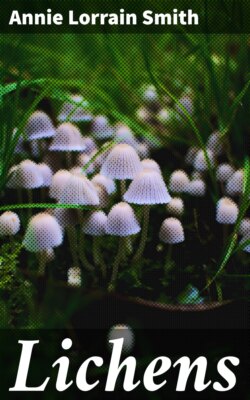Читать книгу Lichens - Annie Lorrain Smith - Страница 28
На сайте Литреса книга снята с продажи.
ОглавлениеFig. 13. Outer edge of Phycopeltis expansa Jenn., the alga attacked by hyphae and passing into separate gonidia × 500 (after Vaughan Jennings).
A somewhat different type of association takes place between alga and fungus in Strigula complanata, an epiphyllous lichen more or less common in tropical regions. Cunningham[221], who found it near Calcutta, described the algal constituent and placed it in a new genus, Mycoidea (Cephaleuros). It forms small plate-like expansions on the surface of the leaf, and also penetrates below the cuticle, burrowing between that and the epidermal cells; occasionally, as observed by Cunningham, rhizoid-like growths pierce deeper into the tissue—into and below the epidermal layer. Very frequently, in the wet season, a fungus takes possession of the alga and slender colourless hyphae creep along its surface by the side of the cell rows, sending out branches which grow downwards. Marshall Ward[222] described the same lichen from Ceylon. He states that the alga may be attacked at any stage, and if it is in a very young condition it is killed by the fungus; at a more advanced period of growth it continues to develop as an integral part of the lichen thallus, but with more frequently divided and smaller cells. Vaughan Jennings[223] observed Strigula complanata in New Zealand associated with a closely allied chroolepoid alga Phycopeltis expansa. He also noted the growth of the fungus over the alga breaking up the plates of tissue and separating the cells which, from yellow, change to a green colour and become rounded off (Fig. 13). The mature lichen, a white thallus dotted with black fruits, contrasts strikingly with the yellow membranous alga. Lichen formation usually begins near the edge of the leaf and the margin of the thallus itself is marked by a green zone showing where the fungus has recently come into contact with the alga.
More recently Hans Fitting[224] has described “Mycoidea parasitica” as it occurs on evergreen leaves in Java. The alga, a species of Cephaleuros, though at first an epiphyte, becomes partially parasitic at maturity. It penetrates below the cuticle to the outer epidermal cells and may even reach the tissue below. When it is joined by the lichen fungus, both constituents grow together to form the lichen. Fitting adds that the leaf is evidently but little injured. In this lichen the alga in the grip of the fungus loses its independence and may be killed off: it is an instance of something like intermittent parasitism.
